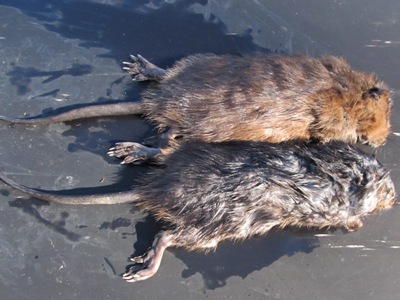
In the Mid Atlantic region, trappers harvest mammals for their fur, meat, scents, and other resources. Although the practice of trapping mammals has its critics, this traditional method of harvesting wild game remains popular. Furbearing mammals of the Mid Atlantic include muskrats, beavers, nutria, bobcats, foxes, raccoons, and river otters.
Aquatic Furbearers
Muskrats are one of the most frequently harvested furbearing mammals. These aquatic rodents exhibit three fur color phases; black, brown, and red. They are usually caught in tidal marshes or other areas where a constant water supply occurs.
Muskrats are valued for their fur as well as meat. In some areas, a demand exists for muskrat meat as a seasonal delicacy. Cooked muskrat yields dark meat similar to beef. Its flavor is said to depend how quickly the animal was cleaned. A variety of muskrat recipes are popular, with stewing and baking being the most common cooking methods.
Beavers are much larger, but less common and more difficult to trap successfully. Their range in the Mid Atlantic states extends from the Appalachian Mountains, east as far as the coastline. In recent years, beaver populations have increased considerably in the region, prompting renewed interest in beaver trapping.
A third aquatic furbearing rodent found in the Mid Atlantic region is the nutria. This non-native species originated in South America. Its introduction in the Mid Atlantic states was intentional, but the species soon became a nuisance. In most areas, the removal of nutrias from their marsh habitats is considered to be a valuable service.
Predatory Mammals
A variety of apex predators are trapped for their fur including red foxes, gray foxes, raccoons, and river otters. A few species, such as foxes and bobcats are usually trapped in upland habitats. Raccoons and river otters, like many other furbearers, are generally harvested along the water’s edge.
Types of Traps
Animal trap designs are based on a variety of factors including regulations, species, trapping habitat, cost, and personal preference. The most common animal trap in use is the traditional Conibear style trap. Conibear-type traps catch most species, usually killing the animal quickly. In some situations, live traps or other designs are used for capturing furbearing species.
Trapping Regulations
Maryland Dept. of Natural Resources
Virginia Dept. of Game and Inland Fisheries